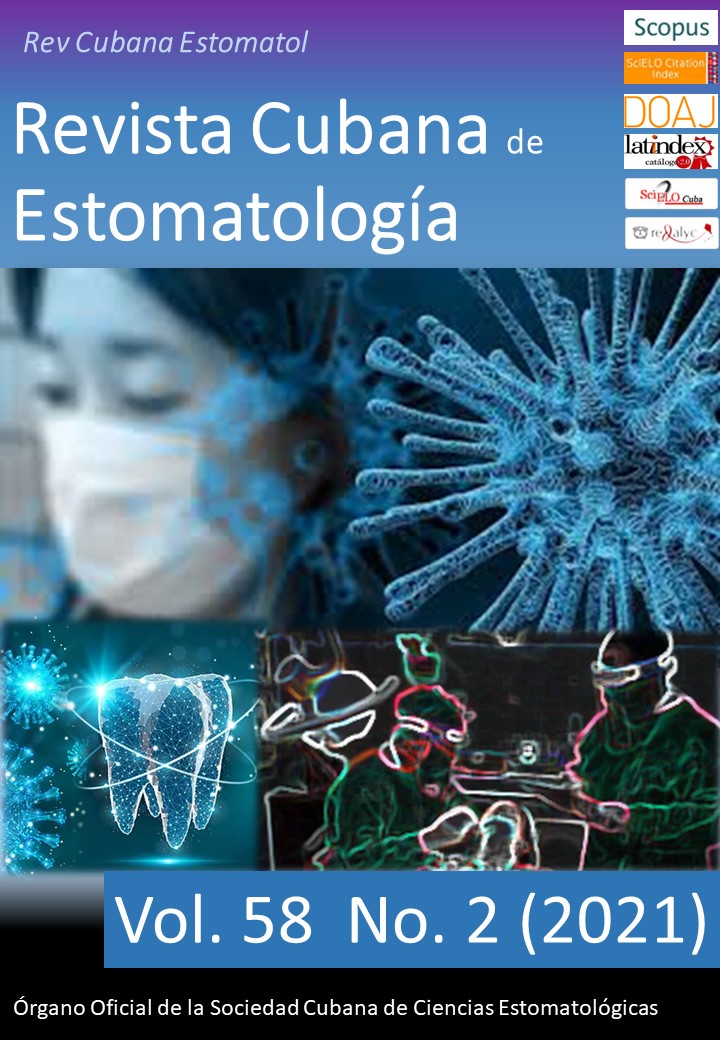Iatrogenic maxillary sinusitis by dental impression material
Keywords:
maxillary sinusitis, oroantral fistula, foreign bodies, silicone, iatrogenic disease, sinus surgery.Abstract
Introduction: The etiology of maxillary sinusitis comprises a number of primary and secondary causes. It is always necessary to initially rule out iatrogenic causes resulting from previous interventions.
Objective: Carry out a review of the different causes of maxillary sinusitis, with an emphasis on the rare iatrogenic causes and the clinical management protocols.
Case presentation: A male 60-year-old patient who experiences episodes of maxillary sinusitis. Surgical antecedents include maxillary cystectomy, treatment for secondary oroantral fistula and posterior prosthetic rehabilitation. Initial radiological examination revealed an intrasinus mass compatible to the touch with dental impression material.
Conclusions: Before any sort of prosthetic rehabilitation and the taking of models, it is important to confirm the absence of an oroantral fistula, to prevent the entrance of foreign material into the maxillary sinus.
Downloads
References
Lechien JR, Filleul O, Costa de Araujo P, Hsieh JW, Chantrain G, Saussez S. Chronic maxillary rhinosinusitis of dental origin: a systematic review of 674 patient cases. Int J Otolaryngol. 2014;2014:465173. DOI: 10.1155/2014/465173
Little RE, Long CM, Loehrl TA, Poetker DM. Odontogenic sinusitis: A review of the current literature. Laryngoscope Investig Otolaryngol. 2018;3(2):110-4. DOI: 10.1002/lio2.147
Arias-Irimia O, Barona-Dorado C, Santos-Marino JA, Martinez-Rodriguez N, Martinez-Gonzalez JM. Metaanalysis of the etiology of odontogenic maxillary sinusitis. Med Oral Patol Oral Cir Bucal. 2010;15:70-3.
Troeltzsch M, Pache C, Troeltzsch M, Kaeppler G, Ehrenfeld M, Otto S, et al. Etiology and clinical characteristics of symptomatic unilateral maxillary sinusitis: A review of 174 cases. J Craniomaxillofac Surg. 2015;43(8):1522-9. DOI: 10.1016/j.jcms.2015.07.021
Tanasiewicz M, Bubilek-Bogacz A, Twardawa H, Skucha-Nowak M, Szklarski T. Foreign body of endodontic origin in the maxillary sinus. J Dent Sci. 2017;12(3):296-300. DOI: 10.1016/j.jds.2013.02.033
Hodnett BL, Ferguson B. Case report: retained gutta-percha as a cause for persistent maxillary sinusitis and pain. F1000Res. 2014;3:81. DOI: 10.12688/f1000research.3791.2
Krishnan S, Sharma R. Iatrogenically induced foreign body of the maxillary sinus and its surgical management: a unique situation. J Craniofac Surg. 2013;24(3):283-4. DOI: 10.1097/SCS.0b013e31828f2a5a
Bodet Agustí E, Viza Puiggrós I, Romeu Figuerola C, Martinez Vecina V. Foreign bodies in maxillary sinus. Acta Otorrinolaringol Esp. 2009;60(3):190-3.
Downloads
Published
How to Cite
Issue
Section
License
Authors retain all rights to their works, which they can reproduce and distribute as long as they cite the primary source of publication.
The Rev Cubana Estomatol is subject to the Creative Commons Attribution-Non-Commercial 4.0 International License (CC BY-NC 4.0) and follows the publication model of SciELO Publishing Schema (SciELO PS) for publication in XML format.
You are free to:
- Share — copy and redistribute the material in any medium or format.
- Adapt — remix, transform, and build upon the material.
The licensor cannot revoke these freedoms as long as you follow the license terms.
Under the following terms:
Attribution — You must give appropriate credit, provide a link to the license, and indicate if changes were made. You may do so in any reasonable manner, but not in any way that suggests the licensor endorses you or your use.
- NonCommercial — You may not use the material for commercial purposes.
No additional restrictions — You may not apply legal terms or technological measures that legally restrict others from doing anything the license permits.
Notices:
- You do not have to comply with the license for elements of the material in the public domain or where your use is permitted by an applicable exception or limitation.
- No warranties are given. The license may not give you all of the permissions necessary for your intended use. For example, other rights such as publicity, privacy, or moral rights may limit how you use the material.


